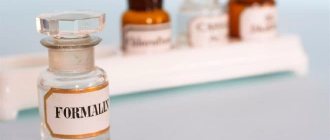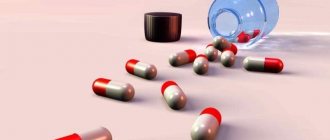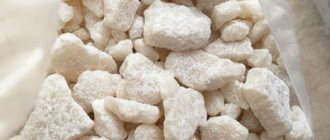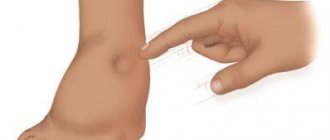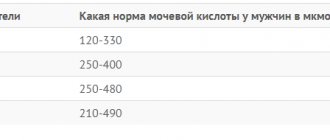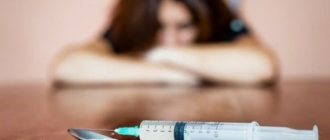Iodine was first discovered in 1811 by the French chemist Bernard Courtois, who discovered it in seaweed ash. Since 1815, Gay-Lussac began to consider iodine as a chemical element.
Under normal conditions, iodine is a solid chemical substance, crystals from black-gray to dark purple in color, having a weak metallic luster and a specific odor. The modern scientific name for iodine is iodine. The name of the element was changed in the 1950s by the International Union of General and Applied Chemistry, the symbol J in the element was changed to I.
How is an iodine overdose possible?
The average daily intake of this chemical element for adults is 120-200 mcg for adults and 50-80 mcg for children. A person receives this amount with proper nutrition and consumption of high-quality water.
The cause of excess iodine intake in the body may be:
- Excessive consumption of seafood;
- Prolonged sea bathing, ingestion of sea water;
- Exceeding the dose of iodine-containing drugs;
- Hyperfunction of the thyroid gland - thyrotoxicosis;
- Accidental ingestion of a substance. Under no circumstances should you drink iodine, as it burns the respiratory tract and mucous membranes;
- Inhalation of vapors of a substance in the event of an accident or non-compliance with safety regulations at work.
Seafood and sea bathing most often affect tourists who have reached the desired resorts.
Unreasonable excess intake of iodine-containing drugs or salt occurs among those who consider iodine a panacea for all diseases, and also abuse inhalations to treat colds. It is not uncommon for young children to drink Lugol's solution, left in an accessible place, as it has a sweet taste.
What to replace it with?
The doctor must identify a microelement deficiency after examining the patient. Medicines and vitamins are used for treatment.
Patients with thyroid diseases and pregnant women should be prescribed iodine-containing drugs by an endocrinologist.
Prevention of iodine deficiency is eating:
- seafood,
- kelp, other edible algae,
- iodized salt,
- vegetables and fruits.
Mandatory salt iodization is carried out in the USA, Switzerland, Kazakhstan, and South Africa. When consuming 5 g of this product, an adult receives a daily dose of the microelement. When the dose was constantly exceeded by 2–2.5 times, no side effects were identified. This salt is suitable for cooking, pickling vegetables and fish.
Symptoms of iodine poisoning
What happens if you drink milk with iodine in excess? After taking a large amount of the substance orally, severe pain and burning in the throat, abdomen, nausea, vomiting, diarrhea mixed with blood, a specific odor from the mouth, and a blue coloration of the oral mucosa occur. These symptoms are caused by a burn of the mucous membranes of the digestive tract.
When inhaling the vapors of this substance, a burning sensation, sore throat, profuse lacrimation and mucus discharge from the nose, difficulty breathing, and severe cough occur.
Common signs of an overdose of iodine in the body for both methods of iodine entering the body are:
- Headache, dizziness, severe general weakness;
- Increased irritability, anxiety, sleep disturbance;
- Cardiopalmus;
- Enlarged thyroid gland (“thick” neck);
- Increased body temperature;
- Characteristic skin rashes (iododerma);
- Nausea, metallic taste in the mouth.
In cases of severe poisoning, severe disturbances of the central nervous system (delirium, hallucinations, confusion or loss of consciousness), acute renal failure (decreased urine output, edema, severe general condition) occur.
Symptoms
Iodine poisoning is called “iodism.” As a rule, such poisoning occurs when inhaling iodine vapor, when introducing iodine into the body, the dose of which is hundreds of times higher than the daily dose. Poisoning can also occur when a person takes iodine for a long time. Residents of coastal areas may also suffer from excess. The phenomenon of iodism is not so easy to identify; sometimes doctors mistakenly call it an allergic reaction.
There are two types of poisoning - acute and chronic. Acute poisoning occurs when a very large dose of iodine enters the human body in a short period of time. Chronic poisoning is considered when iodine is consumed regularly in small doses, but over a long period of time. The complexity and severity of the disease can be determined by the amount of consumption and the way in which this element entered the body. As already mentioned, a symptom of excess can be acute poisoning, which occurs when inhaling iodine vapor and can cause a critically dangerous condition for humans. Immediately after this, pulmonary edema may occur as a result of heart failure. With iodism, most patients experience irritation of the mucous membranes of the skin and respiratory tract. Such symptoms may include swelling and swelling of the salivary glands, resulting in profuse drooling, runny nose, lacrimation and a wet cough with sputum.
Considering all the above symptoms, you can also diagnose a disease called iododerma - a skin lesion. Doctors attribute it to allergic processes, or inflammatory changes in blood vessels. Most often, lesions are observed on the face, neck and limbs. Less common on the body and scalp. Acne appears on the face, which is accompanied by itching and burning. Increasing in size, they turn into painful blue-purple formations from 0.5 to 3 cm. Also, with an excess of iodine, a person may develop diseases such as rubella, urticaria, and in some cases dermatitis. In case of a burn, ulcers form on the affected areas of the skin, which subsequently take a long time to heal. There are other symptoms of excess iodine in the body, such as:
- chronic conjunctivitis and blepharitis;
- decreased visual acuity; in severe cases, cataracts may develop;
- at the formation of eyelashes, scaly skin appears on the upper eyelids;
- metallic taste in the mouth;
- peculiar staining of the oral cavity and a specific odor from the mouth;
- muscle pain, cramps, weakness, diarrhea, emaciation;
- headache, dizziness, nausea and vomiting;
- pain and burning in the throat, hoarseness and severe thirst;
- toxic hepatitis (liver damage);
- yellowness in certain areas of the skin and mucous membranes;
- inflammation of the respiratory tract (pharyngitis, sinusitis, sinusitis, bronchitis);
- weakened immunity and frequent colds, sore throat, pneumonia.
Along with all the above symptoms, excess iodine can not only inhibit the activity of the thyroid gland, but also enhance its activity, which can also harm the human body.
One of the most important substances needed by the body is iodine. The functioning of metabolic processes, for which the thyroid gland is responsible, depends on the consumption of iodine in the right amount. When this substance enters the body in a dose different from the norm, the normal functioning of the thyroid gland is disrupted, which negatively affects the synthesis of thyroid hormones it produces. The normal average daily dose of iodine for an adult is no more than 150 mcg, for children - calculated taking into account age, for pregnant and nursing mothers - up to 200 mcg. Consuming more than 1000 mcg of this substance per day poses a health hazard. Such an excess of iodine in the body provokes the occurrence of thyroid diseases, hormonal imbalance, and it is dangerous due to its toxic (poisonous) effect on the human body.
Iodine poisoning - iodism - can occur due to inhalation of iodine vapor, after introducing into the body exceeding normal doses of this substance (sometimes this happens if you live close to the sea), as a result of long-term use of iodine-containing drugs. Iodism can also cause hypersensitivity to iodine or iodine intolerance. Excess iodine in the body, unfortunately, is a fairly common occurrence for people working in industries that use iodine.
There are two forms of iodine poisoning. The acute form of iodism is characterized by the intake of a large amount of iodine into the body in a short period of time. The chronic form occurs when this substance is regularly ingested into the body in small doses; this form usually develops over years.
Acute poisoning caused by inhalation of iodine vapor can lead to life-threatening pulmonary edema secondary to heart failure. But more often, iodism occurs quite easily, accompanied only by an irritated state of the mucous membranes and skin, and when contact with iodine is stopped, it disappears after a couple of days.
The following symptoms will help you recognize excess iodine in the body:
- lacrimation;
- cough;
- runny nose;
- swelling of the salivary glands;
- skin lesions - iododerma, which appears mainly on the face, neck, limbs, less often on the torso and in the scalp area, manifests itself in the form of acne, in some cases, skin diseases such as rubella, urticaria, erysipelas.
Contact with iodine crystals can cause burns, accompanied by ulcers that take a long time to heal.
More serious signs may occur that make it possible to determine iodism:
- metallic taste in the mouth;
- eye lesions, manifested in impaired light perception, decreased vision, development of conjunctivitis, blepharitis, cataracts;
- nausea and vomiting;
- a sore throat;
- cramps, muscle weakness, numbness of some areas of the skin;
- diarrhea;
- weight loss;
- headache, dizziness;
- toxic hepatitis;
- inflammatory processes of the respiratory system (bronchitis, laryngitis, pharyngitis, sinusitis);
- kidney and stomach diseases (mainly resulting from the use of alcohol tinctures containing iodine);
- lethargy;
- decreased immunity, and, as a result, frequent colds and other infectious diseases.
An excess of iodine in the body can cause spasm (convulsive contraction) or swelling of the larynx and bronchi, leading to suffocation. In some cases, anaphylactic shock develops.
Together with all the signs listed above, an excess of iodine contributes not only to the suppression of the thyroid gland, but also to its strengthening, and this is also dangerous for human health.
Iodine is not produced in the body, it comes only from the outside, which means it is quite possible to take control of its supply, not on your own, of course, but in consultation with an experienced specialist. Prevention is always easier than cure. Moreover, excess iodine not only leads to the development of various diseases, it can also lead to a threat to human life.
Iodine is one of the trace elements necessary for the body to function properly. Among experts, it is called a “micronutrient.” Iodine imbalance is common in our country. All of them negatively affect the general condition and operation of individual systems. From the article you will learn about the importance of the microelement and its role for the body, what is a deficiency and excess of iodine in the body, symptoms in women, as well as ways to cope with these conditions.
First aid for overdose
When a person has inhaled iodine vapor, you need to rinse your mouth and nose thoroughly, put yourself in a reclining position and begin alkaline inhalations. Baking soda is suitable - 1 tablespoon per glass of water, or ammonia - 2 drops per glass of water. You need to breathe over this solution, or it is better to use a nebulizer inhaler. Hot inhalations should not be used, as this will worsen the burn of the respiratory tract. It is also necessary to provide access to fresh air.
If iodine has been taken orally, it is necessary to urgently rinse the stomach using available substances that bind to it.
For rinsing, starch and flour are suitable, from which you need to quickly brew a thin paste, cool or dilute with cold water, and give the victim up to 1 liter of warm water to drink, then induce vomiting by pressing on the root of the tongue.
You can prepare a fat emulsion faster by shaking 1 liter of water well with 1 glass of vegetable oil; you also need to rinse your stomach with it. The rinsing water should be blue, this indicates that the chemical element has combined with starch or oil and is being removed from the stomach.
In both cases, it is necessary to call an ambulance and at the same time begin providing first aid. The more substances that can be removed, the easier the poisoning will be for the victim.
Danger for children
Poisoning in a child occurs with the same symptoms as in an adult.
First aid for a child:
- put the baby to bed;
- secure the limbs in case of cramps (swaddle the baby tightly);
- lay on your back with your head turned to one side. This will help prevent vomit from entering the respiratory tract;
- if vomiting occurs, clean the oral cavity with a soft cloth;
- drink warm liquid in quantities that can cause vomiting;
- at one time the baby can drink up to 200 ml of clean water;
- give the child activated charcoal to drink;
- You can add an antidote to your drink - potato starch;
- if the skin is affected, it should be washed with a baking soda solution. Solution concentration – 20%;
- if the mucous membrane of the eye is affected, wipe the eyes with a damp swab.
Iodine antidote - potato starch
First aid for iodine poisoning should not be a substitute for seeing a doctor. Without being a medical specialist and without knowing the exact dose to which the victim was exposed, it is impossible to predict the consequences for the body.
Antidote iodine, drinking plenty of fluids and an absorbent in the form of activated charcoal can reduce the severity of the damage. However, the child should be monitored by a doctor to avoid long-term consequences.
How to remove iodine from the body?
When there is a suspicion that there is excess iodine in the body, you need to consult a doctor and undergo an examination. The cause of an excess of the substance may be diseases, for example, thyrotoxic goiter, which must be treated. If it comes in excess with food, water or medications, you will have to change your lifestyle and diet.
First of all, you need to exclude iodized salt and seafood from your diet, and drink only purified water. The diet should include eggs, milk, legumes (beans, beans, lentils, peas). They must be consumed daily. Various jelly or mousses prepared with starch, wheat or oatmeal give a good effect.
Is it possible or not?
An alcohol solution of iodine, a liquid for lubricating the throat, belongs to the group of “antiseptics and local irritants.” Used for external treatment of the skin and nasopharyngeal mucosa.
Indications for their use are inflammatory and infectious diseases:
- skin,
- muscles,
- tertiary syphilis.
The instructions for the drugs do not indicate that they are allowed to be used to prevent iodine deficiency.
They are taken orally only for atherosclerosis and tertiary syphilis . The effective dosage is selected by the doctor, but not more than 60 drops per day. The drug is diluted in milk. The maximum course of therapy is 1 month. Treatment is carried out under the guidance of a doctor.
Complications and consequences
Iodine poisoning can cause the following complications:
- Burns of the respiratory tract, asphyxia, pulmonary edema;
- Burns of the digestive tract, internal bleeding;
- Acute renal failure;
- Acute liver failure;
- Acute mental disorders.
Long-term consequences of poisoning are often disorders of the nervous system (neuroses and even mental disorders in the form of fears, hallucinations, delusions). Chronic bronchitis, pneumonia, cardiac disorders, toxic hepatitis, and chronic renal failure may also develop.
After the appearance of skin rashes, an allergic reaction may develop in the form of contact dermatitis, when even with slight contact with a substance or its vapor, a skin rash, swelling of the nasopharynx and larynx appears.
Treatment of intoxication
At the initial stage of detoxification therapy, iodine can be quickly removed from the body by using an antidote. It binds halogen molecules, neutralizing their toxic effects. The best known antidote for iodine is sodium thiosulfate in the form of a solution for parenteral administration. They also wash the victim’s stomach until the fluid leaves without any vomit.
In case of acute poisoning, sedatives and infusion solutions are administered intravenously, and intubation is performed in emergency cases.
In subsequent treatment, the following drugs are used depending on the identified disorders:
- sodium bicarbonate solution;
- potassium-sparing diuretics;
- glucocorticosteroids;
- antiarrhythmic drugs;
- antihypertensive drugs;
- analgesics;
- neuroleptics.
After the patient feels better, it is recommended to follow a gentle diet. This helps speed up the cleansing of the body from excess iodine and restore the functioning of the cardiovascular and endocrine systems.
Prevention of poisoning
Prevention of iodine poisoning is to exclude its excess intake into the body, especially for children, who suffer poisoning much more severely. To do this, you need to remove the product and all its preparations from places accessible to children.
It is not recommended for children with stomatitis or sore throat to use iodine rinsing , lubrication with Lugol's solution, or treatment with Lugol's spray. Inhalations with this substance also need to be agreed with your doctor.
You should not be tempted by various offers to be treated with iodine, which are replete with the Internet (for weight loss, treatment of inflammation, and so on), as well as take nutritional supplements containing it, without consulting your doctor.
Iodine should be stored hermetically sealed, and if it suddenly spills, cover the stain with soda or starch, then rinse with water.
Types of iodine preparations
In medicine and industry, different forms of iodine are used. The most common ones in everyday life are:
- Liquid form Iodine solution is available in 5-10% concentration. It is often used to disinfect skin lesions: wounds, abrasions, scratches.
Iodine solution For internal use People suffering from iodine deficiency are prescribed medications for internal use. Tablets, capsules or syrups also pose a risk of overdose; X-ray contrast solution
Like all medications, iodine-containing medications must be stored under the conditions indicated on the packaging. Before using them, you should consult your doctor or pharmacist.
Lethal dose of a substance
Like any chemical substance, iodine and its preparations require a dosage, the excess of which is dangerous not only for health, but also for life. Severe poisoning develops when 500 mcg of the substance enters the body of an adult, and 150 mcg is dangerous for a child under 14 years of age.
In industries associated with this element, sanitary services regularly monitor the content of its vapors in the air. A concentration of up to 1-1.4 mg per cubic meter is considered safe; more than 1.5 mg/m 3 causes poisoning, and if the vapor concentration reaches 2.5-3 mg/m 3, death can occur.
The cause of death is acute depression of the nervous system and vital functions of the body (respiratory arrest, cardiac arrest).
The high availability of a substance and drugs containing it does not mean that it is harmless to the body. Their use without a doctor’s indication, as well as in excessive doses, or accidental entry into the body can lead to serious consequences.
Victor Systemov – expert of the 1Travmpunkt website
Taking radioactive iodine 131 occurs as a result of the thyroid gland's ability to take up iodine. Sometimes this is not at all an indicator of her active work. Moreover, this result is useful for separating different stages of hypothyroidism. In a disease called arthrosis as a result of complete destruction of the thyroid gland, iodine is absolutely not absorbed.
Endemic cretinism, which appears due to improper synthesis of hormones, in many cases may imply the absorption of iodine in a suspended amount. In this case, it is necessary to perform plasma chromatography on paper to understand the nature of the disorder.
Changing the amount of iodine absorbed is useful after receiving tereotropite.
As a result of the activity of the kidneys, about 2/3 of iodide is produced, this figure is considered normal, the rest is secreted by the thyroid gland. Renal clearance is a constant indicator, because thyroid clearance is quite sensitive.
Therefore, in the case where iodide is low due to alcoholism, for example, or a sufficient amount is not obtained from food, then the round-the-clock absorption of radioactive iodine will be too high. But its huge content during diets leads RAI to a depressing state. The competition between the thyroid gland and the kidneys is implied by a change in the value of RAI in kidney disease and heart failure.
The limited value of iodine is obvious, like other indicators when the gland malfunctions. When the disease is hypothyroidism, the RAI is a particularly low indicator.
Certain absorptions of the substance are also used in TSH injections. An option is possible with patients treated with thyroid drugs.
People who have Graves disease but are euthyroid on TSH do not react. In people with a diseased goiter, the RAI indicator is too high and the number of SBI is very small. For diagnosis, a triiodothyronine test is performed here. In people who are euthyroid, 75 mg of 1-triiodothyronine is administered daily for a week, which leads to a dramatic drop in iodine levels of about 20 percent.
The use of iodine therapy after removal of the thyroid gland
Iodine therapy after removal of the thyroid gland is recommended to destroy both cancer cells and the thyroid gland itself remaining after the operation. After all, one cell is enough for a relapse.
How it works?
Only highly differentiated types of thyroid cancer accumulate iodine. The less differentiated are no longer capable of anything other than unbridled growth. After radioactive isotopes of iodine are introduced into the body, they accumulate in the cells of the thyroid gland itself, if even a microscopic section of it remains after the operation, and in cancer cells, wherever they are. Thus, iodine therapy, or radioiodine therapy, is also effective for cancer metastases.
Treatment with radioactive iodine isotopes also helps to find thyroid cancer if it remains after surgery. To do this, scintigraphy is done, and areas with a high content of injected iodine will “light up” radioactively on the screen.
- The patient's age is 16–45 years. People in this age group tolerate iodine therapy more easily and radioactive iodine gives them a better effect;
- Follicular cancer responds especially well to iodine therapy;
- The diameter of a well-differentiated cancer tumor is at least 1.5 cm;
- Germination into the tissue surrounding the thyroid gland. In this case, no operation can guarantee that the tumor has been completely removed. Radiating iodine will find cancer wherever it is;
- Metastases to the cervical lymph nodes, which therefore merge into conglomerates. Such metastases imply the presence of cancer cells in the lymphatic tract. There is no other way than iodine therapy with radioactive iodine to “catch” them and destroy them;
- Recurrence of local or regional cancer;
- After surgery, there is a high level of thyroglobulin in the blood. This is a direct indication that somewhere in the body there is an unremoved piece of a tumor or simply the thyroid gland, and it is this piece that secretes thyroglobulin.
Side effects and complications
The side effects of any radiation-related treatment look very dangerous, but they occur infrequently and in the benefit/harm ratio they always outweigh the first.
Nausea and vomiting are a normal reaction of the body to radiation, so it is not always possible to suppress the gag reflex.
Bladder cancer is also a possible consequence of iodine therapy. Iodine is excreted by the kidneys in the urine, so the bladder is also significantly irradiated. To reduce the likelihood of such a complication, during the first 3 days of iodine therapy it is recommended to consume as much fluid as possible and go to the toilet very often, reducing the time the bladder is exposed to radioactive urine due to iodine.
Lung fibrosis, pneumonitis and breast cancer are all also the result of radiation. As a complication, iodine therapy is rare; the frequency increases with increasing radiation dose.
How to remove radioactive iodine from the body (video)
Iodine was first discovered in 1811 by the French chemist Bernard Courtois, who discovered it in seaweed ash. Since 1815, Gay-Lussac began to consider iodine as a chemical element.
Under normal conditions, iodine is a solid chemical substance, crystals from black-gray to dark purple in color, having a weak metallic luster and a specific odor. The modern scientific name for iodine is iodine. The name of the element was changed in the 1950s by the International Union of General and Applied Chemistry, the symbol J in the element was changed to I.
The role of iodine in the human body
Iodine in the human body is a very important element, without which our body cannot develop normally.
The daily dose of iodine is 150-200 mcg, which ensures the normal production of hormones in the thyroid gland that control fat and carbohydrate metabolism, the muscular and nervous systems, as well as our body temperature.
In addition, iodine is involved in the formation of phagocytes (protective cells of the body), which remove damaged and foreign cells from the body.
With a lack of iodine in the body, complex mental complications and complications of mental development, metabolism, and the development of cancer are possible. Iodine is involved in protein synthesis, the formation of osteochondral tissues and stimulates human performance and mental capabilities.
The level of iodine in the human body affects the functioning of our nervous system, the burning of fat in the body, metabolism, as well as the condition of the skin, hair, nails and teeth.
The human body contains up to 25 mg of iodine. More than half of its mass is contained in the thyroid gland, about 10-5% is concentrated in the blood. Despite the rather small amount of iodine in the body, its importance is very high . Almost its entire mass is located in the thyroid gland, which greatly affects our body and regulates metabolism.
Iodine deficiency leads to serious disruptions in all body systems.
As a result, the mental and physical development of a person weakens, and endemic goiter occurs.
Hyperthyroidism
With an excess of iodine, the thyroid gland begins to work very hard. The endocrine system produces more thyroid-stimulating hormones, which leads to hormonal disorders. It is the enhanced synthesis of hormonal substances that provokes excess iodine in the body. Hyperthyroidism develops, which can be stopped only at the initial stage.
The disease can cause overgrowth of the thyroid gland and the appearance of a goiter, protrusion of the eyeballs, deterioration of memory and concentration. It is accompanied by insomnia, nervous breakdowns, cardiac arrhythmias and tachycardia.
Lack of iodine in the body, symptoms:
Around the world, about 1.5 billion people and about 70% of the Russian population suffer from iodine deficiency. In areas with severe iodine deficiency in the body, the average IQ is 20% lower. Everyone needs to monitor the iodine content in the body, and this is especially important for children and pregnant women.
Lack of iodine in the body of women (pregnant women):
- congenital fetal deformity;
- stillbirth;
- infertility;
- miscarriage;
- retardation of children in growth and development;
For all:
- mental retardation;
- risk of developing thyroid cancer:
- decreased physical and intellectual capabilities;
- decreased ability to work;
- headache;
- increased blood pressure and cholesterol levels in the blood;
- weakened immunity;
- severe fatigue and fatigue;
- irritability increases;
- incomplete thyroid function;
- endometrial goiter;
- weakening of memory;
- weight gain is possible.
Excess iodine in the body
Excess iodine is also very dangerous for the body; with excess iodine, an increase in the amount of mucus in the nose is possible, the appearance of allergic symptoms: colds, hives, etc.
A person receives 90% of iodine from food, and the remaining 10% from air and water. In its pure form, one teaspoon of iodine will last you 75 years of life!
What are the daily norms for iodine intake? Daily, according to the recommendations, you should consume:
- 50 mcg for infants, up to 12 months;
- 90 mcg for children from 1 to 7 years;
- 120 mcg for children from 7 to 12 years old;
- 150 mcg for adults and adolescents 12+;
- 200 mcg for pregnant and lactating women.
What foods contain iodine?
Iodine-containing foods should be in everyone's diet. What foods contain iodine?
The richest foods with iodine are seafood. The main foods containing iodine are fish, namely salmon, halibut, herring, tuna, cod, sea bass, and flounder.
Its concentration is approximately 70 mcg per 100 grams of raw sea fish.
In cod liver it is slightly higher, about eight hundred micrograms per hundred grams. Fish oil contains 770 mcg per 100 grams.
To ensure your daily requirement of iodine, it is enough to eat 180 grams of cod daily.
Freshwater fish also contains iodine, but its concentration is very low, from 5 to 8 mcg per 100 grams.



